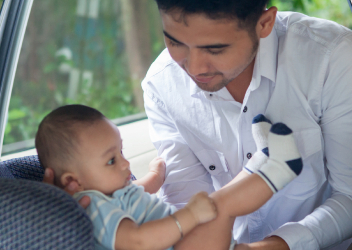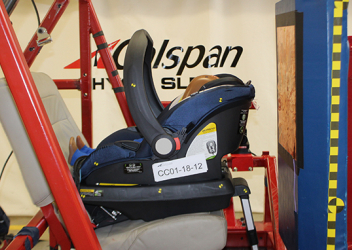Child Occupant Protection Research
Motor vehicle crashes are a leading cause of death and disability among all children, and result in more than 400,000 injuries to children less than 18 years old annually. The Center has been investigating child occupant protection for more than two decades, when its founders identified the deployment of front passenger air bags as a cause of fatal injury for children, even in minor crashes.
Because children are not simply "small adults," there remains a need for research into age-appropriate child restraint systems, vehicle designs for optimal child protection, and best practices for child occupant protection.
Biomechanics data are needed to improve specific body regions of pediatric anthropometric test devices (ATDs), commonly referred to as crash test dummies, and to develop innovative restraint products to make vehicles safer for children in the future.
Current Child Occupant Protection Projects
- Dynamic Volunteer Testing
Low Acceleration Time Extended Events
In a collaboration between CIRP, Drexel University, and the University of Virginia, this line of research aims to quantify the movement of motor vehicle occupants during pre-crash avoidance maneuvers utilizing a sled that mimics vehicle swerving.
Principal Investigator: Kristy Arbogast, PhD
Funding: TK Holdings Inc. (Takata Corp.)
Motion and Muscle Activation of Young Volunteers in Evasive Vehicle Maneuvers
In partnership with The Ohio State University Injury Biomechanics Research Center and the University of Virginia Center for Applied Biomechanics, this project builds on the Low Acceleration Time Extended Events project and examines responses of rear seat occupants to emergency maneuvers in a real vehicle rather than in a laboratory setting.
Principal Investigators: Kristy Arbogast, PhD; Valentina Graci, PhD
Funding: Toyota Collaborative Safety Research Center.
- Restraint Design, Testing, and Optimization
An Analysis of the Interaction between Child Occupants and Deploying Frontal Passenger Air Bags- A Modern Examination
This project explores and quantifies the injury potential for children in front of a deploying modern front passenger air bag for those in forward-facing child restraints and booster seats across a range of misuse conditions and crash scenarios.
Principal Investigator: Aditya Belwadi, PhD
Funding: Center for Child Injury Prevention Studies (CChIPS)
Analysis of the Response of Shield-based Child Restraints with Human Body Models
This project explores and builds upon the first open source human body finite element model of a 6-year-old, PIPER, to understand responses in a shield child restraint. Responses of the PIPER model will be compared to a traditional 6-year-old Q series dummy.
Principal Investigator: Aditya Belwadi, PhD
Funding: CYBEX Inc.
- Child Passenger Safety and Behavioral Science
Parental Driving Behaviors of Child Passengers Ages 4-10 Years
This study aims to create a broader picture related to parental driving behaviors and the implications on child passengers and, ultimately, teen drivers. By investigating factors influencing booster seat use, misuse and non-use, as well as developing an understanding of how risky driving behaviors like distracted driving may be associated with child passenger safety practices, more precise targets for interventions for parents as drivers can be developed.
Principal Investigator: Catherine McDonald, PhD, RN, FAAN
Funding: Center for Child Injury Prevention Studies (CChIPS)
Watch this video from Jalaj Maheshwari, MSE about how our researchers are using computational modeling in child occupant protection research:












